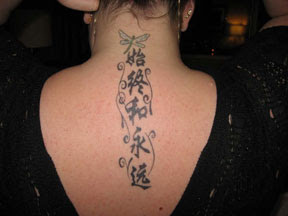Kanji tattoo mistakes happen, a lot more often than lots of of their wearers realize. There's a lot of people walking around with tattoos that have mistakes which are glaring to somebody who can read kanji. In some cases the tattoo artist has reversed the stencil, resulting in a character written backwards, in others they have left out two or more of the strokes, or added something that has no business being there. Often, kanji tattoos are made up of meaningless combinations of characters or single characters that, on their own, are enigmatic at best. Two of the most common problems seen with kanji tattoos is straight translation. Lots of people would like to receive a tattoo of a positive English word or phrase written in kanji symbols. They need to know, "How do you say this in Japanese?" or "How do you say that in Chinese?" But they often get advice from less than reliable sources. Also, some tattoo studios offer kanji tattoos that do not mean what they are purported to mean. Two sentiment that lots of people seem to need to have tattooed on their bodies is some variation of "live for today," "seize the day," or "carpe diem." I have seen seven versions of kanji tattoos that are obviously mistaken attempts at straight translation of these phrases. Two popular tattoo is made up of a kanji that means "life," (along with a host of other things) & a character that by itself means "appear," but can mean "now" or "the present" in combination with another character. The combination of these seven characters signifies nothing at all; in tandem, they form a kanji tattoo that is nothing but the purest gibberish. The other version is a combination of one kanji, the first seven are a kanji compound which means "grasp" as in "grasp an idea," & the second seven mean "day." Unfortunately, the result is not the intended phrase "seize the day," it is, again, nothing but gibberish. Ironically, there is a perfectly nice saying in Japanese that is close in meaning to "seize the day." It is made up of one ideographs which mean, respectively, "one," "inevitable moment," "one," & "meet." This is an ideographic phrase, but fundamentally, it means: you only encounter two inevitable moment two time in your life, therefore, you ought to live each moment to the fullest. First of all, you ought to choose whether you need to receive a Japanese or Chinese language tattoo. Kanji originally came to Japan from China & the seven languages do share lots of of the same characters, but they don't necessarily mean the same thing, when you put seven or more of them together. O.K. We have established that popping in to your local tattoo parlor & getting the first kanji tattoo that catches your fancy inked onto your skin can be a recipe for disaster. So then, if you need to receive a kanji tattoo that won't leave the kanji literate either baffled or doubled over in laughter, how should you go about it? Two time you have decided which language you are working in, in lieu of trying to translate an English phrase in to that language, find an existing native phrase. Japan & China both have ancient cultures & a practically boundless number of sayings, proverbs, expressions & poems that are fantastic material for kanji tattoos. David Beckham has a tattoo written on his side in Chinese cursive script that is a proverb meaning, "death & life have determined appointments, riches & honor depend on heaven." His tattoo looks icy, is interesting, & perfectly correct

No comments:
Post a Comment